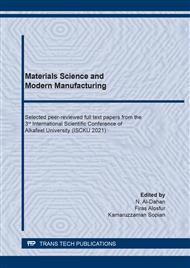[1]
M. M. Jamadar and M. V. Kavade: International Journal of Mechanical and Production Engineering Vol. 2, 8 (2014), p.25.
Google Scholar
[2]
S. Kumar and S. Dhanabalan: Springer Nature Applied Sciences Vol. 1, 396 (2019), p.1.
Google Scholar
[3]
S. K. Sahu and S. Datta: Proceedings of the Institution of Mechanical Engineers, Part E: Journal of Process Mechanical Engineering Vol. 233, 2 (2019), p.1.
Google Scholar
[4]
M. G. Rathi and. D. V. Mane: International Journal of Scientific and Research Publications Vol. 4, 11 (2014), p.1.
Google Scholar
[5]
G. S. Prihandana, M. Mahardika and T. Sriani: Appl. Sci. Vol. 10 (2020), p.1.
Google Scholar
[6]
F. Klocke, M. Zeis, A. Klink and D. Veselova: Proceedings of the 1st CIRP Global Web Conference on Interdisciplinary Research in Production Engineering Vol. 2 (2012), p.98.
Google Scholar
[7]
S. K. Majhi, M. K. Pradhan and H. Soni: International Journal of Applied Research in Mechanical Engineering Vol. 3, 1 (2013), p.82.
Google Scholar
[8]
R. Krishnan, S. Dinesh, V. Swaminthan and Naveen: International Journal of Advance Research, Ideas and Innovations in Technology Vol. 4, 2 (2018), p.1530.
Google Scholar
[9]
X. Li, D. Wei, Q. Li and X. Yang: The International Journal of Advanced Manufacturing Technology Vol. 107 (2020), p.4403.
Google Scholar
[10]
S. K. Majhi, T. K. Mishra, M. K. Pradhan and S. Hargovind: International Journal of Current Engineering and Technology Vol. 4, 1 (2014), p.19.
Google Scholar
[11]
B. B. Patel and K. B. Rathod: International Journal of Scientific and Engineering Research Vol. 3, 6 (2012), p.1.
Google Scholar
[12]
T. C. Bhagat, B. L. Seth and H. S. Payal: Indian Journal of Science and Technology Vol. 5, 10 (2012), p.3428.
Google Scholar
[13]
J. E. Abu Qudeiri, A. Zaiout, A. I. Mourad, M. H. Abidi and A. Elkaseer: Applied Sciences Vol. 10, 6 (2020), p.1.
Google Scholar
[14]
P. Chaudhury and, S. Samantaray: Annales de Chimie - Science des Matériaux Vol. 43, 4 (2019), p.273.
Google Scholar
[15]
A. N. Al-Khazraji, , S. A. Amin, and S. M. Ali: Eng. And Tech. Journal Vol 33 Part A, 6 (2015), p.1399.
Google Scholar
[16]
P. J. Liew, C. Y. Yap, J. Wang, T. Zhou and J. Yan: Int. J. Extrem. Manuf. Vol. 2 (2020), p.1.
Google Scholar
[17]
B. Xin, M. Gao, S. Li and B. Feng: Mathematical Problems in Engineering, Article ID 5652197 (2020), p.1.
Google Scholar
[18]
J. Anbesh, A. Ankur, G. Nishant and D. Akhil: International Research Journal of Engineering and Technology Vol. 5, 2 (2018), p.433.
Google Scholar
[19]
B. Nahak and A. Gupta: Manufacturing Rev. Vol. 6, 2 (2019), p.1.
Google Scholar
[20]
F. Klockea, L. Hensgena, A. Klinka, L. Ehleb and A. Schwedtb: Procedia CIRP Vol. 42 (2016), p.673.
Google Scholar
[21]
Y. C. Lin, B. H. Yan and F. Y. Huang: Int. J. Adv. Manuf. Technol. Vol. 18, 9 (2001), p.673.
Google Scholar
[22]
B. Reddy, G. N. Kumar and K. Chandrashekar: International Journal of Current Engineering and Technology Vol. 4, 3 (2014), p.1218.
Google Scholar
[23]
S. Reddy and C. S. Rao: Research Journal of Engineering Sciences Vol. 2, 1 (2013), p.21.
Google Scholar
[24]
J. E. Abu Qudeiri, A. Saleh, A. Ziout, A. I. Mourad, M. H. Abidi and A. Elkaseer: Materials Vol. 12, 907 (2019), p.1.
DOI: 10.3390/ma12060907
Google Scholar
[25]
R. Swiercz, D. O. Swiercz and T. Chmielewski: Micromachines Vol. 10, 72 (2019), p.1.
Google Scholar
[26]
L. Gu, L. Le., W. Zhao, and K. P. Rajurkar: International Journal of Machine Tools and Manufacturing Vol. 53 (2012), p.100.
Google Scholar
[27]
S. K. Sahu, T. Jadam, S. Datta and G. Nandi: Journal of the Brazilian Society of Mechanical Sciences and Engineering Vol. 40, 330 (2018), P. 1400.
Google Scholar
[28]
A. N. Al-Khazraji, S. A. Amin, and S. M. Ali: Journal of Solid Mechanics Vol. 10,2 (2018), p.338.
Google Scholar
[29]
ASTM A370: Standard Test Method and Definitions for Mechanical Testing of Steel Products (American Society for Testing and Materials, Washington, D.C. 1977).
Google Scholar
[30]
ASTM A681, Standard Specification for Tool Steels Alloy (American Society for Testing and Materials, Washington, D.C. 1976).
Google Scholar
[31]
V. Yadav, V. K. Jain, and P. M. Dixit: International Journal of Machine Tools and Manufacture Vol. 42 (2002), p.877.
Google Scholar
[32]
D. Shuvra, K. Mathias and F. Klocke: Journal of Materials Processing Technology Vol. 142 (2003), p.434.
Google Scholar
[33]
D. D. Dibitonto, P. T. Eubank, M. R. Patel and M. A. Barrufet: Journal of Applied Physics Vol. 66 (1989), p.4095.
Google Scholar
[34]
R. Bhattacharya, V. K. Jain and P. S. Ghoshdastidar: IE (I) Journal-PR Vol. 77 (1996), p.13.
Google Scholar
[35]
H. P. Schulze, R. Herms, H. Juhr, W. Schaetzing and G. Wollenberg: Journal of Materials Processing Technology Vol. 149 (2004), p.316.
DOI: 10.1016/j.jmatprotec.2004.02.016
Google Scholar
[36]
J. Marafona and J. A. Chousal: International Journal of Machine Tools and Manufacture Vol. 46 (2006), p.595.
Google Scholar
[37]
ISO 3297, Certified Organization: International Journal of Innovative Research in Science, Engineering and Technology Vol. 3, 2 (2014).
Google Scholar
[38]
S. M. Ali: 2nd International Conference on Engineering Technology and its Applications, IEEE Xplore, (2020), p.1.
Google Scholar
[39]
J. Singh and P. M. Pandey: Proceedings of the Institution of Mechanical Engineers, Part C: Journal of Mechanical Engineering Science Vol. 234, 1 (2020), p.66.
Google Scholar
[40]
B. Raymond and A. Hancq: Calculating and Displaying Fatigue Results-The ANSYS Fatigue Module (New Technologies, ANSYS Inc. 2006).
Google Scholar
[41]
J. E. Shigley and C. R. Mischke: Mechanical Engineering Design (McGraw-Hill Inc. 8th ed. 2006).
Google Scholar


